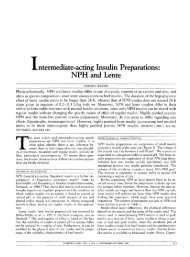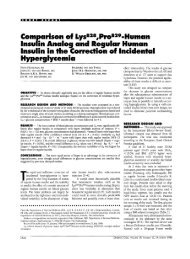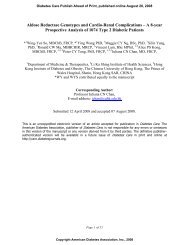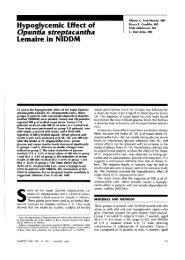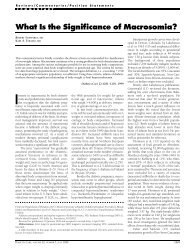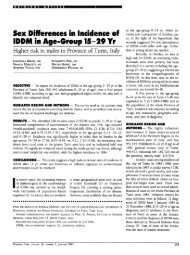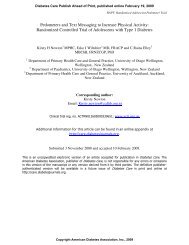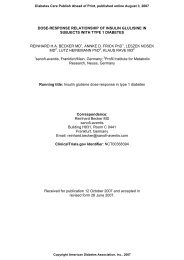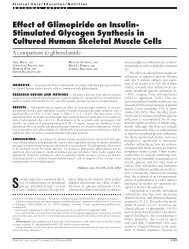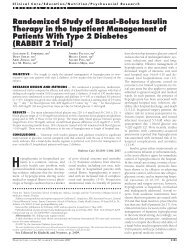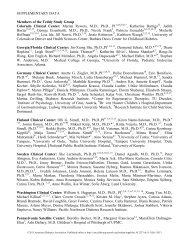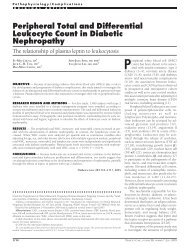The Sensory Symptoms of Diabetic Polyneuropathy ... - Diabetes Care
The Sensory Symptoms of Diabetic Polyneuropathy ... - Diabetes Care
The Sensory Symptoms of Diabetic Polyneuropathy ... - Diabetes Care
Create successful ePaper yourself
Turn your PDF publications into a flip-book with our unique Google optimized e-Paper software.
Emerging Treatments and Technologies<br />
O R I G I N A L A R T I C L E<br />
<strong>The</strong> <strong>Sensory</strong> <strong>Symptoms</strong> <strong>of</strong> <strong>Diabetic</strong><br />
<strong>Polyneuropathy</strong> Are Improved With<br />
�-Lipoic Acid<br />
<strong>The</strong> SYDNEY Trial<br />
THE SYDNEY TRIAL AUTHORS, FOR THE<br />
SYDNEY TRIAL STUDY GROUP:<br />
ALEXANDER S. AMETOV, MD 1<br />
ALEXEI BARINOV, MD 2<br />
PETER J. DYCK, MD 3<br />
ROBERT HERMANN, MD 4<br />
NATALIA KOZLOVA, MD 5<br />
WILLIAM J. LITCHY, MD 6<br />
PHILLIP A. LOW, MD 3<br />
DETLEF NEHRDICH, DIPL STAT 4<br />
MARIA NOVOSADOVA, MD 5<br />
PETER C. O’BRIEN, PHD 3<br />
MIROSLAV RELJANOVIC, MD 6<br />
RUSTEM SAMIGULLIN, MD 4<br />
KLEMENS SCHUETTE, BSC 3<br />
IGOR STROKOV, MD 1<br />
HANS J. TRITSCHLER, PHD 4<br />
KLAUS WESSEL, PHD 4<br />
NIKOLAI YAKHNO, MD 2<br />
DAN ZIEGLER, MD 7<br />
OBJECTIVE — Because �-lipoic acid (ALA), a potent antioxidant, prevents or improves<br />
nerve conduction attributes, endoneurial blood flow, and nerve (Na(�)K(�) ATPase activity in<br />
experimental diabetes and in humans and may improve positive neuropathic sensory symptoms,<br />
in this report we further assess the safety and efficacy <strong>of</strong> ALA on the Total Symptom Score (TSS),<br />
a measure <strong>of</strong> positive neuropathic sensory symptoms.<br />
RESEARCH DESIGN AND METHODS — Metabolically stable diabetic patients with<br />
symptomatic (stage 2) diabetic sensorimotor polyneuropathy (DSPN) were randomized to a<br />
parallel, double-blind study <strong>of</strong> ALA (600 mg) (n � 60) or placebo (n � 60) infused daily<br />
intravenously for 5 days/week for 14 treatments. <strong>The</strong> primary end point was change <strong>of</strong> the sum<br />
score <strong>of</strong> daily assessments <strong>of</strong> severity and duration <strong>of</strong> TSS. Secondary end points were sum scores<br />
<strong>of</strong> neuropathy signs (NIS), symptoms (NSC), attributes <strong>of</strong> nerve conduction, quantitative sensation<br />
tests (QSTs), and an autonomic test.<br />
RESULTS — At randomization, the groups were not significantly different by the criteria <strong>of</strong><br />
metabolic control or neuropathic end points. After 14 treatments, the TSS <strong>of</strong> the ALA group had<br />
improved from baseline by an average <strong>of</strong> 5.7 points and the placebo group by an average <strong>of</strong> 1.8<br />
points (P � 0.001). Statistically significant improvement from baseline <strong>of</strong> the ALA, as compared<br />
with the placebo group, was also found for each item <strong>of</strong> the TSS (lancinating and burning pain,<br />
asleep numbness and prickling), NIS, one attribute <strong>of</strong> nerve conduction, and global assessment<br />
<strong>of</strong> efficacy.<br />
CONCLUSIONS — Intravenous racemic ALA, a potent antioxidant, rapidly and to a significant<br />
and meaningful degree, improved such positive neuropathic sensory symptoms as pain and<br />
●●●●●●●●●●●●●●●●●●●●●●●●●●●●●●●●●●●●●●●●●●●●●●●●●<br />
From the 1 Russian Medical Academy for Advanced Studies, Moscow, Russia; 2 Neurology Clinic, Moscow<br />
Medical Academy, Russia; 3 Mayo Clinic, Rochester, Minnesota; 4 Viatris GmbH, Frankfurt, Germany;<br />
5 6 7<br />
Health Partners Medical Group, Minneapolis, Minnesota; Ergomed, Zagreb, Croatia; and the German<br />
<strong>Diabetes</strong> Research Institute, University <strong>of</strong> Düsseldorf, Germany.<br />
This report was prepared by P.J.D.<br />
Address correspondence and reprint requests to Peter J. Dyck, MD, Mayo Clinic, 200 First St. SW,<br />
Rochester, MN 55905. E-mail: dyck.peter@mayo.edu.<br />
Received for publication 1 August 2002 and accepted in revised form 10 December 2002.<br />
P.J.D., W.J.L., P.A.L., and D.Z. have received honoraria from Vitaris GmbH and/or have served on an<br />
advisory panel for Vitaris GmbH, the manufacturer <strong>of</strong> �-lipoic acid.<br />
Abbreviations: ALA, �-lipoic acid; DSPN, diabetic sensorimotor polyneuropathy; HP-DB, heart pulse<br />
deep breathing; ITT, intent-to-treat; NIS, neuropathy impairment score; NIS(LL), NIS <strong>of</strong> lower limbs; NSC,<br />
neuropathy symptoms and change; NSC(LL), neuropathy symptoms and change <strong>of</strong> lower limbs; PP, per<br />
protocol; QST, quantitative sensation test; TSS, Total Symptom Score.<br />
A table elsewhere in this issue shows conventional and Système International (SI) units and conversion<br />
factors for many substances.<br />
several other neuropathic end points. This improvement<br />
<strong>of</strong> symptoms was attributed to<br />
improved nerve pathophysiology, not to increased<br />
nerve fiber degeneration. Because <strong>of</strong><br />
its safety pr<strong>of</strong>ile and its effect on positive neuropathic<br />
sensory symptoms and other neuropathic<br />
end points, this drug appears to be a<br />
useful ancillary treatment for the symptoms <strong>of</strong><br />
diabetic polyneuropathy.<br />
<strong>Diabetes</strong> <strong>Care</strong> 26:770–776, 2003<br />
<strong>The</strong> neuropathies associated with diabetes<br />
are heterogeneous (1). Perhaps<br />
the most common variety is<br />
diabetic sensorimotor polyneuropathy<br />
(DSPN), the disorder studied here. This<br />
variety appears to be caused by chronic<br />
hyperglycemia and associated metabolic<br />
derangements, damaging neurons (axons)<br />
or Schwann cells (or myelin) directly<br />
or indirectly by functional and structural<br />
alterations <strong>of</strong> microvessels or the blood<br />
nerve barrier. Inflammation, perhaps<br />
from immune mechanisms, may also be<br />
implicated in some cases (2).<br />
Recognizing that total hyperglycemic<br />
exposure may be the most important<br />
modifiable risk covariate for diabetic<br />
complications such as DSPN (3–8), why<br />
search for ancillary treatments in addition<br />
to rigorous glucose control? First, despite<br />
considerable effort to achieve near euglycemia<br />
(by frequent monitoring <strong>of</strong> plasma<br />
glucose, use <strong>of</strong> multiple injections <strong>of</strong> insulin,<br />
or use <strong>of</strong> insulin pumps), many diabetic<br />
patients cannot, or will not, achieve<br />
the desired level <strong>of</strong> metabolic control<br />
(3,8). Such patients might benefit from<br />
ancillary treatments. Second, the mechanisms<br />
underlying positive neuropathic<br />
sensory symptoms may be different or<br />
overlapping from ones relating to neuropathic<br />
impairment (9). Among the ancillary<br />
therapies considered are aldose<br />
reductase inhibitors (10), myo-inositol<br />
(11), essential fatty acids (12,13), vitamins,<br />
protein kinase C inhibitors, vasodi-<br />
770 DIABETES CARE, VOLUME 26, NUMBER 3, MARCH 2003
lators (14), antiprostaglandins (15), nerve<br />
growth factors (16), ACE inhibitors, lipid-lowering<br />
agents, advanced glycation<br />
end product inhibitors (17), acetyl-Lcarnitine<br />
(18), and �-lipoic acid (ALA)<br />
(19)—the drug studied here.<br />
Prevention or amelioration <strong>of</strong> positive<br />
neuropathic sensory symptoms deserve<br />
attention because symptoms are troublesome;<br />
create anxiety and depression; interfere<br />
with work, activities <strong>of</strong> daily living,<br />
meeting family and social responsibilities,<br />
and attaining adequate rest and sleep; and<br />
bring patients to see their medical provider<br />
(20).<br />
Because there already are drugs that<br />
relieve positive neuropathic sensory<br />
symptoms (e.g., analgesics, antidepressants,<br />
tranquilizers, anti-epileptic agents,<br />
sedatives, or opiates), putative ancillary<br />
treatments should relieve symptoms by<br />
improving the pathophysiology <strong>of</strong> nerve<br />
and not by causing nerve injury. With<br />
prolonged use they might also be expected<br />
to prevent or improve neuropathy<br />
(20). Here we test whether positive neuropathic<br />
sensory symptoms can be ameliorated<br />
by the potent antioxidant ALA<br />
that has additional favorable metabolic<br />
actions (21–25). Racemic ALA, 6,8dithioctane<br />
(the active ingredient studied<br />
here) is widely distributed in biological<br />
tissues and has a low toxicity pr<strong>of</strong>ile (26–<br />
30). In dosages ranging from 100 to 1,800<br />
mg/day (given orally or intravenously),<br />
ALA has been used extensively in medical<br />
practice in Germany since 1959, and it is<br />
considered to be safe and efficacious for<br />
the treatment <strong>of</strong> diabetic polyneuropathy<br />
symptoms (29–32). Using the improved<br />
approaches learned from the performance<br />
<strong>of</strong> earlier therapeutic trials we here retest<br />
whether intravenous ALA is efficacious<br />
for treatment <strong>of</strong> the positive neuropathic<br />
sensory symptoms <strong>of</strong> pain, paresthesia,<br />
and asleep numbness. Further, assuming<br />
that the drug is efficacious, we examined<br />
whether this effect is attributable to improved<br />
pathophysiology <strong>of</strong> nerve or to a<br />
different mechanism (i.e., degeneration <strong>of</strong><br />
sensory nerve fibers).<br />
Study design and demographic<br />
characteristics <strong>of</strong> patients<br />
This is a mono-center, randomized, doubly<br />
masked, parallel-designed study <strong>of</strong> intravenous<br />
ALA versus placebo given in 14<br />
doses over 3 weeks on the positive neuropathic<br />
sensory symptoms <strong>of</strong> burning and<br />
lancinating pain, asleep numbness, and<br />
Table 1—<strong>Symptoms</strong>* and scoring† <strong>of</strong> the<br />
TSS (31)<br />
Frequency<br />
Intensity<br />
Not<br />
present Mild Moderate Severe<br />
Occasionally 0 1.00 2.00 3.00<br />
Often 0 1.33 2.33 3.33<br />
Continuous 0 1.66 2.66 3.66<br />
*<strong>The</strong> symptoms scored: sticking or lancinating pain,<br />
burning, prickling, or asleep numbness. Each <strong>of</strong><br />
these is a positive neuropathic sensory symptom.<br />
†Scoring: total score 0–14.64.<br />
prickling (Total <strong>Symptoms</strong> Score [TSS])<br />
<strong>of</strong> feet or legs in 120 patients (60 patients<br />
per group, 18–74 years old) with symptomatic<br />
(stage 2) diabetic polyneuropathy.<br />
Patients had to have type 1 or 2<br />
diabetes (according to American <strong>Diabetes</strong><br />
Association criteria); HbA 1c �12%; a TSS<br />
(Table 1) �7.5 points (<strong>of</strong> a possible maximum<br />
<strong>of</strong> 14.64 points); neurologic signs<br />
(neuropathy impairment score [NIS] �2<br />
points, described below); nerve conduction<br />
or heart pulse deep breathing (HP-<br />
DB) abnormality; and during the run-in<br />
period (the first week), the TSS must not<br />
improve by �3 points. Patients were excluded<br />
if they had confounding neurologic<br />
disease or neuropathy; symptomatic<br />
peripheral vascular disease; or clinically<br />
complicating cardiac, pulmonary, gastrointestinal,<br />
hematologic or endocrine disease,<br />
or malignancy.<br />
Initially, one <strong>of</strong> us (R.S.) presented<br />
the outline <strong>of</strong> the study to Moscow endocrinologists.<br />
Of the names provided, 790<br />
were interviewed by telephone, 497 were<br />
prescreened, 206 were screened, and 120<br />
patients were admitted to the hospital<br />
study unit for the 4-week study. <strong>The</strong>y<br />
signed informed consent to receive either<br />
the drug or placebo with double masking;<br />
however, for the first week, all patients<br />
received placebo. After randomization,<br />
on Monday <strong>of</strong> week 2 and thereafter for<br />
14 treatments, as shown in Fig. 1, patients<br />
received either racemic ALA (600 mg) or<br />
placebo (0.04 mg <strong>of</strong> rib<strong>of</strong>lavin, to give the<br />
solution a straw color to match ALA),<br />
each made-up to a final volume <strong>of</strong> 225 ml<br />
with physiologic saline and given intravenously<br />
over 30 min. <strong>The</strong> solutions were<br />
prepared by the sponsoring company<br />
(ASTA Medica, Inc., now Viatris Inc.),<br />
shipped in a concentrated form to the<br />
study site identified only by coded num-<br />
<strong>The</strong> SYDNEY Trial Authors<br />
ber, and diluted to the final volume. In<br />
weeks 2 and 3, infusions were given daily,<br />
Monday through Friday; and in the fourth<br />
week, only four infusions were given<br />
(Monday through Thursday). Patients followed<br />
their usual diabetic surveillance<br />
and treatment regimens during the conduct<br />
<strong>of</strong> the study. Physicians were encouraged<br />
to reduce HbA 1c to levels below<br />
8 or 9%, but patients were not excluded if<br />
this degree <strong>of</strong> control had not been<br />
achieved. Vital signs, weight, and metabolic<br />
alterations (especially diabetic,<br />
hepatic, and renal alterations) were monitored<br />
before, during, and after treatment.<br />
Assessment <strong>of</strong> neuropathic end<br />
points<br />
<strong>The</strong> primary end point was the TSS, which<br />
is a summation <strong>of</strong> the presence, severity,<br />
and duration <strong>of</strong> lancinating pain, burning<br />
pain, prickling, and asleep numbness (Table<br />
1). TSS was evaluated daily (just before<br />
infusion and on treatment days) by<br />
the same neurologist (M.N.) in order to<br />
reduce interobserver variability. Standard<br />
questioning and scoring was used. Secondary<br />
end points, evaluated before and<br />
during the first week and at the end <strong>of</strong> the<br />
fourth week, were the NIS, the NIS <strong>of</strong><br />
lower limbs [NIS(LL)]), neuropathic<br />
symptoms <strong>of</strong> lower limbs (neuropathy<br />
symptoms and change <strong>of</strong> lower limbs<br />
(NSC[LL]), nerve conductions, and HP-<br />
DB; each <strong>of</strong> these end points was assessed<br />
twice, at onset and at end <strong>of</strong> the study.<br />
<strong>The</strong> NIS is the sum score <strong>of</strong> a standard<br />
group <strong>of</strong> examinations <strong>of</strong> muscle weakness<br />
(0 � normal to 4 � paralyzed); reflex<br />
loss (0 � normal and 2 � absent with<br />
reinforcement); and touch-pressure, vibration,<br />
joint position and motion, and<br />
pinprick (0 � normal and 2 � absent and<br />
for each modality) <strong>of</strong> index finger and<br />
great toe and is scored for both sides <strong>of</strong> the<br />
body. Age, sex, physical fitness, and anthropomorphic<br />
features are to be taken<br />
into account in making judgements <strong>of</strong> abnormality.<br />
Typically, persons without<br />
neuropathy would have a score <strong>of</strong> 0. A<br />
person with mild weakness <strong>of</strong> toe extensors<br />
(1 and 1) and ankle dorsiflexor muscles<br />
(1 and 1), absent ankle reflexes (2 and<br />
2), and decrease <strong>of</strong> all four sensory modalities<br />
<strong>of</strong> the great toes (4 and 4) would<br />
have a score <strong>of</strong> 16 points. <strong>The</strong> NSC scores<br />
(number, severity, and change) are derived<br />
from answers to 38 questions (muscle<br />
weakness, Q1–19; sensation, Q20–<br />
29; and autonomic symptoms, Q30–38)<br />
DIABETES CARE, VOLUME 26, NUMBER 3, MARCH 2003 771
<strong>Diabetic</strong> polyneuropathy: the SYDNEY Trial<br />
(20). <strong>The</strong> questions are also subdivided<br />
by anatomical site (head and neck, chest,<br />
upper limbs and lower limbs); by large<br />
fiber sensory function; by small fiber sensory<br />
function; by positive sensory symptoms<br />
(Q23–29 and separable by five<br />
sites); by negative sensory symptoms<br />
(Q20–22 for five sites); and by pain<br />
(Q25–29 for five sites). Number equals<br />
number <strong>of</strong> symptoms (<strong>of</strong> 38), and severity<br />
equals number � severity (1 � mild, 2 �<br />
moderate, and 3 � severe). Change in<br />
number and severity is obtained by subtracting<br />
the mean <strong>of</strong> the two end values<br />
from the mean <strong>of</strong> the onset values. <strong>The</strong><br />
change score is the patient’s comparison<br />
<strong>of</strong> the symptoms at last evaluation to the<br />
symptoms at onset (unchanged � 0, improved<br />
[1 � slightly, 2 � moderately, or<br />
3 � much], or worsened [�1, �2, or<br />
�3]). <strong>The</strong> NSC (number, severity, and<br />
change) are independent measures <strong>of</strong><br />
symptoms, whereas the remainder <strong>of</strong> the<br />
scores are subscores. Experienced and<br />
certified (by P.J.D. and colleagues) neurologists<br />
(A.B. and M.N.) evaluated the<br />
NIS and NSC.<br />
<strong>The</strong> nerve conduction, QSTs, and autonomic<br />
tests were performed by trained<br />
and certified personnel (by W.J.L., P.J.D.,<br />
P.A.L., and colleagues). All neurologic,<br />
nerve conduction, and QST results were<br />
interactively evaluated by the Reading<br />
and Quality Assurance Centers (at Mayo<br />
Clinic and Health Partners). Eligibility,<br />
baseline conditions, waveforms, stimulus<br />
response patterns, and test values were<br />
also assessed.<br />
Analysis plan<br />
Based on previously reported results<br />
(33,34), the study was designed for 120<br />
patients (60 in each group) to achieve<br />
80% power to detect a difference between<br />
treatment groups <strong>of</strong> 1.0 point <strong>of</strong> the primary<br />
end point, assuming a SD <strong>of</strong> 1.8<br />
points. <strong>The</strong> primary end point was change<br />
in TSS from the first day <strong>of</strong> treatment to<br />
the termination visit. <strong>The</strong> corresponding<br />
primary analysis for comparing the treatment<br />
groups was a two-sample t test at the<br />
0.05 level. All results are reported as twosided<br />
tests.<br />
Regression analysis was also used, including<br />
treatment group, sex, and duration<br />
<strong>of</strong> diabetes as independent variables<br />
to account for imbalance (albeit small and<br />
Table 2—Patient characteristics<br />
not significant for duration) between<br />
treatment groups with respect to the latter<br />
two variables. Wilcoxon’s rank-sum tests<br />
were used to compare groups with respect<br />
to continuous secondary end points because<br />
many <strong>of</strong> these were highly skewed.<br />
� 2 tests were used to compare treatment<br />
groups for dichotomous variables.<br />
<strong>The</strong> analysis followed the intent-totreat<br />
(ITT) principle. A per protocol analysis<br />
was also conducted for the primary<br />
end point.<br />
RESULTS<br />
Figure 1—ALA (intravenous racemic<br />
ALA, 600 mg/day, 5 days/<br />
week) was given on the 14<br />
treatment days as shown. Placebo<br />
(intravenous rib<strong>of</strong>lavin in physiologic<br />
saline) was also given on the<br />
14 treatment days. <strong>The</strong> color, rate<br />
<strong>of</strong> infusion, and total volume was<br />
essentially similar between placebo<br />
and ALA. Most patients reported<br />
that they thought they had<br />
received ALA, although only onehalf<br />
had.<br />
Patient characteristics<br />
<strong>The</strong>se are shown in Table 2. No patients<br />
needed to be excluded after the first week<br />
because they were hyper-responders.<br />
During the trial, one patient was withdrawn<br />
from study because <strong>of</strong> fever (later<br />
ALA Placebo P<br />
n 60 60 NS<br />
Age (years) 56.8 � 9.65 55.4 � 8.66 NS<br />
Sex (M/F) 14/46 24/36 0.06<br />
Type <strong>of</strong> diabetes (1/2) 15/45 15/45 NS<br />
Duration <strong>of</strong> diabetes (years) 15.1 � 8.8 14.0 � 8.2 NS<br />
Duration <strong>of</strong> neuropathy (years) 3.7 � 6.0 3.4 � 3.9 NS<br />
Height (cm) 163.9 � 8.01 167.3 � 9.74 NS<br />
BMI (kg/m 2 ) 29.4 � 4.93 29.3 � 5.23 NS<br />
Data are means � SD.<br />
772 DIABETES CARE, VOLUME 26, NUMBER 3, MARCH 2003
Table 3—Neuropathy symptom and change (NSC) scores<br />
Score<br />
attributed to an upper respiratory viral infection)<br />
and a second because <strong>of</strong> cardiac<br />
arrhythmia (later diagnosed as paroxysmal<br />
supraventricular tachycardia). Both<br />
had been on placebo. Following completion<br />
<strong>of</strong> the study, six patients were found<br />
to have laboratory values just outside the<br />
acceptable range (five had received placebo<br />
and one ALA). <strong>The</strong> results, therefore,<br />
were evaluated as ITT, including persons<br />
with protocol violations and as per protocol<br />
(PP), excluding the six patients). Because<br />
the results <strong>of</strong> ITT and PP were<br />
essentially alike, only the results <strong>of</strong> ITT<br />
are shown.<br />
Adverse events<br />
Of the 120 patients, 8 experienced a total<br />
<strong>of</strong> 11 adverse events: 4 with or immediately<br />
following treatment events, during<br />
the single-blind run-in phase; 1 with<br />
ALA; and 3 with placebo. No adverse<br />
event (AE) was judged to be causally related<br />
to the trial medication.<br />
Efficacy<br />
At baseline, there were no significant demographic,<br />
anthropomorphic, or disease<br />
differences between treatment groups except<br />
for a higher ratio <strong>of</strong> men to women in<br />
the placebo group (Table 2). After 14<br />
treatments over 3 weeks, the mean value<br />
<strong>of</strong> the primary end point (TSS) had improved<br />
by a mean <strong>of</strong> 5.72 points (�1.53)<br />
for ALA and a mean <strong>of</strong> 1.83 points<br />
(�1.97) for placebo (P � 0.001) (Fig. 2).<br />
Mean at<br />
onset<br />
(points)<br />
Mean change<br />
(points)<br />
ALA* PLA ALA PLA<br />
Wilcoxon<br />
P value<br />
NSC—number 9.4 10.1 �4.2 �2.2 �0.001<br />
NSC—severity 18.4 20.5 �11.1 �7.2 �0.001<br />
NSC—change 0.2 0.0 14.5 9.2 �0.001<br />
NSC Weakness—severity 0.0 0.0 0.0 0.0 NS<br />
NSC <strong>Sensory</strong>—number 7.2 7.6 �3.3 �1.4 �0.001<br />
NSC <strong>Sensory</strong>—severity 14.9 16.4 �9.4 �5.7 �0.001<br />
NSC <strong>Sensory</strong>—change 0.2 0.0 12.4 7.4 �0.001<br />
NSC(LL) Sensation—severity 14.9 5.5 �9.4 �5.7 �0.001<br />
NSC(LL) Large-Fiber Sensation—severity 2.8 3.1 �1.2 �0.6 �0.001<br />
NSC(LL) Small-Fiber Sensation—severity 12.1 13.3 �8.3 �5.1 �0.001<br />
NSC(LL) Negative Sensation—severity 2.7 3.5 �1.2 �0.7 0.043<br />
NSC(LL) Positive Sensation—severity 12.2 12.9 �8.3 �5.0 �0.001<br />
NSC(LL) Pain—severity 10.0 10.6 �7.3 �4.6 �0.001<br />
NSC Autonomic—severity 3.5 4.2 �1.7 �1.5 NS<br />
*n � 60; PLA, placebo, n � 58.<br />
<strong>The</strong> difference between treatment groups<br />
remained statistically significant (P �<br />
0.001) in regression analysis taking into<br />
account the greater preponderance <strong>of</strong> females<br />
in the ALA group. A very small but<br />
statistically significant difference (P �<br />
0.021) favoring ALA was first observed on<br />
the fourth treatment day, with the degree<br />
<strong>of</strong> the difference increasing and remaining<br />
significant thereafter (Fig. 1). Each <strong>of</strong><br />
the four component symptoms <strong>of</strong> the TSS<br />
was assessed individually, and significantly<br />
greater improvement was found,<br />
favoring ALA over placebo, for each <strong>of</strong><br />
them.<br />
<strong>The</strong> NSC score, a 38-question survey<br />
<strong>of</strong> motor, sensory (positive and negative),<br />
and autonomic symptoms, was used as an<br />
independent measure <strong>of</strong> change <strong>of</strong> neuropathic<br />
symptoms (20). <strong>The</strong> mean change<br />
<strong>of</strong> motor or autonomic scores (number,<br />
severity, and change) was not significantly<br />
different between ALA and placebo.<br />
By contrast, large and statistically<br />
significant greater improvement <strong>of</strong> positive<br />
pain (stabbing, deep aching, burning,<br />
and excessive tenderness to contact<br />
or pressure; prickling; and asleepnumbness)<br />
and negative (loss <strong>of</strong> tactile,<br />
thermal, and pain sensation) neuropathic<br />
sensory symptoms had occurred with use<br />
<strong>of</strong> ALA as compared with placebo (Table<br />
3). Also, patients’ judgement <strong>of</strong> symptom<br />
change from baseline was significantly<br />
larger for ALA than for placebo (P �<br />
0.001). ALA also improved the following<br />
<strong>The</strong> SYDNEY Trial Authors<br />
symptom scores to a better degree than<br />
did placebo at the P � 0.001 level:<br />
NSC(LL)—number, severity, and change;<br />
NSC(LL) Sensation—number and<br />
change; NSC(LL) Large-Fiber Sensation—change;<br />
NSC(LL) Small-Fiber Sensation—number<br />
and change; NSC(LL)<br />
Negative Sensation—number; NSC(LL)<br />
Positive Sensation—number and change;<br />
NSC(LL) Pain—number and change;<br />
NSC(LL) Small-Fiber � Autonomic—<br />
number, severity, and change. Significant<br />
at the 0.05 level: NSC(LL) Large-Fiber<br />
Sensation—number; NSC(LL) Negative<br />
Sensation—change.<br />
Another secondary measure, the NIS,<br />
improved by 2.7 points (�3.37) in ALA<br />
and by 1.2 points (�4.14) in placebo<br />
(P � 0.001), but the NIS <strong>of</strong> lower limbs<br />
did not quite reach statistical significance<br />
(P � 0.076). Significant differences were<br />
not found between ALA and placebo for<br />
change in individual or composite scores<br />
<strong>of</strong> attributes <strong>of</strong> nerve conduction except<br />
for distal latency <strong>of</strong> the sural nerve, which<br />
improved more in the ALA (mean beginning<br />
minus end difference <strong>of</strong> –0.86 ms)<br />
than in placebo (mean difference <strong>of</strong> 0.353<br />
ms, P � 0.017). No significant change<br />
was found for QST or for autonomic test<br />
results.<br />
<strong>The</strong> treating physician graded the response<br />
to treatment in the ALA group as<br />
very good or good in 66.7% and as satisfactory<br />
in 33.3%; whereas for placebo, the<br />
judgements were very good or good in<br />
1.7%, satisfactory in 68.3%, unsatisfactory<br />
in 26.7%, and not assessable in 3.3%<br />
(P � 0.001).<br />
Patients judged overall efficacy following<br />
ALA as very good or good in 80%<br />
and as satisfactory in 20%. For placebo,<br />
the ratios and percents were very good or<br />
good in 8.3%, satisfactory in 73.3%, and<br />
unsatisfactory in 15%; two patients were<br />
not assessed. <strong>The</strong> difference in percent <strong>of</strong><br />
very good or good versus other was significantly<br />
better (P � 0.001) for the ALA<br />
group.<br />
<strong>The</strong> beneficial effect <strong>of</strong> ALA on neuropathic<br />
symptoms could not be attributed<br />
to a greater improvement in<br />
metabolic control. <strong>The</strong> HbA 1c <strong>of</strong> the ALA<br />
group had improved (from onset to end)<br />
by a mean value <strong>of</strong> 0.22%, whereas the<br />
placebo group had improved by a mean<br />
value <strong>of</strong> 0.12% (P � 0.05).<br />
CONCLUSIONS — Various end<br />
points have been used to assess efficacy<br />
DIABETES CARE, VOLUME 26, NUMBER 3, MARCH 2003 773
<strong>Diabetic</strong> polyneuropathy: the SYDNEY Trial<br />
in treatment trials <strong>of</strong> diabetic polyneuropathy:<br />
sum scores <strong>of</strong> neurologic abnormalities<br />
(e.g., the NIS), QSTs, nerve<br />
conduction, autonomic tests, combinations<br />
<strong>of</strong> these, and morphometry <strong>of</strong> nerve.<br />
In the present study, we use positive neuropathic<br />
sensory symptoms using TSS. An<br />
Ad Hoc Panel on End points for <strong>Diabetic</strong><br />
Neuropathy Trials (20) had previously<br />
defined positive neuropathic sensory<br />
symptoms, discussed their use as trial end<br />
points, cited approaches for their assessment,<br />
and defined the degree <strong>of</strong> change<br />
that might be considered clinically meaningful<br />
and able to meet standards for being<br />
efficacious in controlled trials.<br />
Assuming that in such a trial the study<br />
was rigorously performed and doubly<br />
masked, it would be necessary to first<br />
show a statistically significant degree <strong>of</strong><br />
symptom change for the trial drug<br />
above that found for the placebo; the degree<br />
<strong>of</strong> change should be <strong>of</strong> sufficient<br />
magnitude to be considered meaningful<br />
and should not have been due to worsening<br />
<strong>of</strong> neuropathy.<br />
In using the TSS, a four-item measure<br />
<strong>of</strong> positive neuropathic sensory symptoms,<br />
as the primary outcome, as done<br />
here, we imply that these symptoms alone<br />
may be serious and debilitating health<br />
outcomes irrespective <strong>of</strong> the degree <strong>of</strong><br />
neuropathic findings or impairments. It is<br />
increasingly recognized that positive neuropathy<br />
sensory symptoms are separate<br />
phenomena from negative symptoms<br />
(loss <strong>of</strong> tactile, thermal, pain, or other sensations)<br />
or from severity <strong>of</strong> neuropathic<br />
signs or impairments. Thus, for some patients<br />
with onset <strong>of</strong> polyneuropathy, positive<br />
symptoms may predominate without<br />
or with only a few neuropathic findings.<br />
Later, as positive neuropathic sensory<br />
symptoms abate, negative symptoms and<br />
impairments may become evident and<br />
worsen. Also, we note that these positive<br />
sensory symptoms may be more bothersome<br />
than negative neuropathic sensory<br />
symptoms, may inspire patients seeking<br />
relief from pain to visit physicians, and<br />
may be more debilitating (interfering with<br />
meeting work, family, and social responsibilities)<br />
than negative symptoms or impairments.<br />
<strong>The</strong>se positive neuropathic<br />
symptoms are thought to be due to smallfiber<br />
sensory nerve fiber involvement. Although<br />
it is known that analgesics and<br />
anti-epileptic and tranquilizing medications<br />
may relieve positive neuropathic<br />
sensory symptoms, we here test the idea<br />
that symptoms may be improved by another<br />
mechanism, e.g., by improving the<br />
pathophysiology <strong>of</strong> nerves.<br />
<strong>The</strong> present study appears to show an<br />
unequivocal and large beneficial effect <strong>of</strong><br />
intravenous racemic ALA on the frequency<br />
and severity <strong>of</strong> the positive neuropathic<br />
sensory symptoms due to<br />
diabetic polyneuropathy, the effect <strong>of</strong><br />
which cannot be attributed to placebo or<br />
to worsening <strong>of</strong> polyneuropathy. <strong>The</strong><br />
conclusion that the improvement is indicative<br />
<strong>of</strong> pharmacological efficacy comes<br />
also from the observations that the effect<br />
was statistically significant, was found for<br />
each component <strong>of</strong> the TSS, and was confirmed<br />
by similar results from independent<br />
assessments <strong>of</strong> symptoms using a<br />
separate clinical instrument (NSC) and<br />
that the improvement was sufficiently<br />
large to be considered meaningful by<br />
standards set by an ad hoc consensus<br />
panel (20). Additionally, efficacy was suggested<br />
by the time course <strong>of</strong> improvement<br />
(it was delayed and then increasingly improved<br />
over the treatment period, not<br />
rapidly, and then static or fading as would<br />
be expected with analgesics and opiates)<br />
(35), negative sensory symptoms and<br />
neuropathic impairment also improved,<br />
and the effect could not be explained by<br />
bias (patients had remained masked). Additionally,<br />
further analysis indicated that<br />
the treatment effect could not be explained<br />
by the unequal distribution by<br />
gender.<br />
This beneficial effect from ALA had<br />
previously been reported (see references<br />
in ref. 22). By comparison with earlier<br />
studies, the present study was more rigorous<br />
in the following respects: a placebo<br />
run-in phase, pretraining and certification<br />
<strong>of</strong> investigators, interobserver variability<br />
was reduced by use <strong>of</strong> a single<br />
investigator performing critical end point<br />
evaluations, retention <strong>of</strong> essentially all patients<br />
throughout the study, use <strong>of</strong> reading<br />
and quality assurance <strong>of</strong> neuropathic<br />
end points, independent analysis <strong>of</strong> results,<br />
and evidence that masking was<br />
maintained.<br />
Since it is generally thought that abnormalities<br />
<strong>of</strong> attributes (or composite<br />
scores) <strong>of</strong> nerve conduction or <strong>of</strong> HP-DB<br />
are among the most sensitive indicators <strong>of</strong><br />
diabetic polyneuropathy, why did these<br />
end points not show statistically significant<br />
improvement with use <strong>of</strong> ALA? Why<br />
did QST not show improvement? To begin<br />
with, one attribute (sural nerve la-<br />
tency) did show statistically significant<br />
improvement. Also, recognition <strong>of</strong> worsening<br />
by nerve conduction assessment<br />
may be more sensitive than recognition <strong>of</strong><br />
improvement, and the latter may take<br />
more time. Thus, in the <strong>Diabetes</strong> Control<br />
and Complications Trial (DCCT), a statistically<br />
significant difference in nerve conduction<br />
was not recognized until several<br />
years had elapsed (6,7). In human neuropathies,<br />
it is common clinical experience<br />
that improvement or recovery <strong>of</strong><br />
nerve conduction may lag well behind<br />
clinical improvement.<br />
<strong>The</strong> mechanisms underlying the improvement<br />
<strong>of</strong> positive neuropathic sensory<br />
symptoms was not studied here, but<br />
antioxidant activity appears to be the<br />
likely mechanism. <strong>The</strong>re is accumulating<br />
evidence from experimental animal and<br />
tissue culture studies that full radicalmediated<br />
oxidative stress is implicated in<br />
the pathogenesis <strong>of</strong> diabetic polyneuropathy<br />
by inducing neurovascular defects<br />
that result in endoneurial hypoxia and<br />
subsequent nerve dysfunction (36–39).<br />
Administration <strong>of</strong> physiological antioxidants,<br />
including ALA, a potent lipophilic<br />
free radical scavenger (40,41),<br />
provides a basis for a potential therapeutic<br />
effect. <strong>Diabetic</strong> peripheral nerves demonstrate<br />
footprints <strong>of</strong> oxidative stress and respond<br />
to treatment with lipoic acid (42).<br />
More recently, these findings have been<br />
supplanted by immunocytochemical evidence<br />
<strong>of</strong> DNA damage and cellular localization<br />
(43). Reduced oxygen species<br />
cause irreversible DNA damage to specific<br />
proteins. In recent years, antibodies have<br />
been generated against modified structures<br />
specific for reactive oxidative species–induced<br />
damage (43). <strong>The</strong> epitopes<br />
include 8-hydroxy-2�-deoxyguanosine<br />
and 4-hydroxy-2-nonenal-modified<br />
protein (44). Urinary 8-hydroxy-2�deoxyguanosine<br />
(8-OHdG) has been reported<br />
to be increased in human diabetes<br />
(45,46).<br />
Finally, the lack <strong>of</strong> toxicity to ALA in<br />
our trial is perhaps not surprising since<br />
several million dosages <strong>of</strong> the drug have<br />
already been given by German physicians,<br />
and toxicity appears to be extremely<br />
low (29,30). No toxicity was<br />
recognized in the present trial.<br />
Acknowledgments— <strong>The</strong> study was sponsored<br />
and paid for by ASTA Medica, Inc.,<br />
Frankfurt, Germany. P.J.D. receives grant sup-<br />
774 DIABETES CARE, VOLUME 26, NUMBER 3, MARCH 2003
port from a National Institutes <strong>of</strong> Neurologic<br />
Disease and Stroke grant (NS36797).<br />
References<br />
1. Dyck PJ, Giannini C: Pathologic alterations<br />
in the diabetic neuropathies <strong>of</strong> humans:<br />
a review. J Neuropathol Exp Neurol<br />
55:1181–1193, 1996<br />
2. Younger DS, Rosoklija G, Hays AP, Trojaborg<br />
W, Latov N: <strong>Diabetic</strong> peripheral<br />
neuropathy: a clinicopathologic and<br />
immunohistochemical analysis <strong>of</strong> sural<br />
nerve biopsies. Muscle Nerve 19:722–727,<br />
1996<br />
3. Dyck PJ, Davies JL, Wilson DM, Service<br />
FJ, Melton LJ, O’Brien PC: Risk factors for<br />
severity <strong>of</strong> diabetic polyneuropathy: intensive<br />
longitudinal assessment <strong>of</strong> the<br />
Rochester <strong>Diabetic</strong> Neuropathy Study cohort.<br />
<strong>Diabetes</strong> <strong>Care</strong> 22:1479–1486, 1999<br />
4. Service FJ, Rizza RA, Daube JR, O’Brien<br />
PC, Dyck PJ: Near normoglycaemia improved<br />
nerve conduction and vibration<br />
sensation in diabetic neuropathy. Diabetologia<br />
28:722–727, 1985<br />
5. Amthor K-F, Dahl-Jorgensen K, Berg TJ,<br />
Skard Heier M, Sandvik L, Aagenaes O,<br />
Hanssen KF: <strong>The</strong> effect <strong>of</strong> 8 years <strong>of</strong> strict<br />
glycaemic control on peripheral nerve<br />
function in IDDM patients: the Oslo<br />
Study. Diabetologia 37:579–584, 1994<br />
6. <strong>The</strong> <strong>Diabetes</strong> Control and Complications<br />
Trial Research Group: <strong>The</strong> effect <strong>of</strong><br />
intensive treatment <strong>of</strong> diabetes on the development<br />
and progression <strong>of</strong> long-term<br />
complications in insulin-dependent diabetes<br />
mellitus. N Engl J Med 329:977–986,<br />
1993<br />
7. DCCT Research Group: <strong>The</strong> <strong>Diabetes</strong><br />
Control and Complications Trial (DCCT):<br />
design and methodologic considerations<br />
for the feasibility phase. <strong>Diabetes</strong> 35:530–<br />
545, 1986<br />
8. Greene DA, Stevens MJ, Feldman EL: Glycemic<br />
control. In <strong>Diabetic</strong> Neuropathy.<br />
2nd ed. Dyck PJ, Thomas PK, Eds. Philadelphia,<br />
W.B. Saunders Company, 1999,<br />
p. 297–315<br />
9. Willner C, Low PA: Pharmacologic approaches<br />
to neuropathic pain. In Peripheral<br />
Neuropathy. 3rd ed. Dyck PJ, Thomas<br />
PK, Griffin JW, Low PA, Poduslo JF, Eds.<br />
Philadelphia, W.B. Saunders Company,<br />
1993, p. 1709–1720<br />
10. Tomlinson DR: Role <strong>of</strong> aldose reductase<br />
inhibitors in the treatment <strong>of</strong> diabetic<br />
polyneuropathy. In <strong>Diabetic</strong> Neuropathy.<br />
2nd ed. Dyck PJ, Thomas PK, Eds. Philadelphia,<br />
W. B. Saunders Company, 1999,<br />
p. 330–340<br />
11. Gregersen G: Myo-inositol supplementation.<br />
In <strong>Diabetic</strong> Neuropathy. 1st ed. Dyck<br />
PJ, Thomas PK, Asbury AK, Winegrad AI,<br />
Porte D, Eds. Philadelphia, W.B. Saunders<br />
Company, 1987, p. 188–189<br />
12. Cameron NE, Cotter MA: Role <strong>of</strong> linolenic<br />
acid in diabetic polyneuropathy. In <strong>Diabetic</strong><br />
Neuropathy. 2nd ed. Dyck PJ,<br />
Thomas PK, Eds. Philadelphia, W.B.<br />
Saunders Company, 1999, p. 359–367<br />
13. Jamal GA, Carmichael H: <strong>The</strong> effect <strong>of</strong><br />
gamma-linolenic acid on human diabetic<br />
peripheral neuropathy: a double-blind<br />
placebo-controlled trial. Diabet Med<br />
7:319–323, 1990<br />
14. Cameron NE, Cotter MA, Low PA: Nerve<br />
blood flow in early experimental diabetes<br />
in rats: relation to conduction deficits.<br />
Am J Physiol 261:E1–E8, 1991<br />
15. Yasuda H, Kikkawa R: Role <strong>of</strong> antiprostaglandins<br />
in diabetic neuropathy. In <strong>Diabetic</strong><br />
Neuropathy. 2nd ed. Dyck PJ,<br />
Thomas PK, Eds. Philadelphia, W.B.<br />
Saunders Company, 1999, p. 368–376<br />
16. Feldman EL, Windebank AJ: Growth factors<br />
and peripheral neuropathy. In <strong>Diabetic</strong><br />
Neuropathy. 2nd ed. Dyck PJ,<br />
Thomas PK, Eds. Philadelphia, W.B.<br />
Saunders Company, 1999, p. 377–386<br />
17. Brownlee M: Advanced glycation end<br />
products and diabetic peripheral neuropathy.<br />
In <strong>Diabetic</strong> Neuropathy. 2nd ed.<br />
Dyck PJ, Thomas PK, Eds. Philadelphia,<br />
W. B. Saunders Company, 1999, p. 353–<br />
358<br />
18. Quatraro A, Roca P, Donzella C, Acampora<br />
R, Marfella R, Giugliano D: Acetyl-Lcarnitine<br />
for symptomatic diabetic<br />
neuropathy (Letter). Diabetologia 38:123,<br />
1995<br />
19. Low PA, Nickander KK, Scionti L: Role<br />
<strong>of</strong> hypoxia, oxidative stress, and excitatory<br />
neurotoxins in diabetic neuropathy.<br />
In <strong>Diabetic</strong> Neuropathy. 2nd ed.<br />
Dyck PJ, Thomas PK, Eds. Philadelphia,<br />
W.B. Saunders Company, 1999, p.<br />
317–329<br />
20. Ad Hoc Panel on Endpoints for <strong>Diabetic</strong><br />
Neuropathy Trials: Positive neuropathic<br />
sensory symptoms as endpoints in diabetic<br />
neuropathy trials. J Neurol Sci 189:<br />
3–6, 2001<br />
21. Packer L, Witt EH, Tritschler HJ: Alphalipoic<br />
acid as a biological antioxidant (Review<br />
Article). Free Radic Biol Med 19:227–<br />
250, 1995<br />
22. Biewanga G, Vriesmann MF, Haenen<br />
GRMM, Bast A: <strong>The</strong> identification <strong>of</strong> a<br />
new metabolite <strong>of</strong> lipoic acid in man:<br />
3-ketolipoic acid. In Lipoic Acid: a Pharmacochemical<br />
Study. Biewanga G, Ed. Amsterdam,<br />
Vrije Universiteit Amsterdam,<br />
1997, p. 137–152<br />
23. Bravenboer B, Kappelle AC, Hamers FPT,<br />
van Buren T, Erkelens DW, Gispen WH:<br />
Potential use <strong>of</strong> glutathione for the prevention<br />
and treatment <strong>of</strong> diabetic neuropathy<br />
in the streptozotocin-induced diabetic<br />
rat. Diabetologia 35:813–817, 1992<br />
24. Packer L: Interactions among antioxidants<br />
in health and disease: vitamin E and<br />
<strong>The</strong> SYDNEY Trial Authors<br />
its redox cycle. Proc Soc Exp Biol Med 200:<br />
271–276, 1992<br />
25. Schmidt P, Grafen P, Goedde HW: Chemie<br />
und biochemie der liponsäure. Angewandte<br />
ChemieInternational Edin English<br />
77:900–911, 1965<br />
26. Eger W: Thioctsaure bei Leberschadigung.<br />
Angew Med 11:251–255, 1957<br />
27. Fuke H, Ivanami K, Watanabe N, Kumada<br />
S: Acute, subacute and chronic toxicity <strong>of</strong><br />
lipoic acid in rats. Folia Pharmacol Japan<br />
68:256–275, 1972<br />
28. Kirnberger E, Braun W, Stille G, Wolf W:<br />
Beziehungen zwischen leberschultz und<br />
zucherst<strong>of</strong>fwechsel. Arznm Forsch/Drug<br />
Res 1:72–76, 1958<br />
29. Ziegler D, Reljanovic M, Mehnert H, Gries<br />
FA: Alpha-lipoic acid in the treatment <strong>of</strong><br />
diabetic polyneuropathy in Germany:<br />
current evidence from clinical trials. Exp<br />
Clin Endocr <strong>Diabetes</strong> 107:421–430, 1999<br />
30. Ziegler D, Gries FA: �-Lipoic acid in the<br />
treatment <strong>of</strong> diabetic peripheral and cardiac<br />
autonomic neuropathy. <strong>Diabetes</strong> 46<br />
(Suppl. 2):S62–S66, 1997<br />
31. Ziegler D, Conrad F, Ulrich H: Effects <strong>of</strong><br />
treatment with the antioxidant �-lipoic<br />
acid on cardiac autonomic neuropathy in<br />
non-insulin-dependent diabetic patients:<br />
a 4-month randomized controlled multicenter<br />
trial (DEKAN-study). <strong>Diabetes</strong> <strong>Care</strong><br />
20:369–373, 1997<br />
32. Ziegler D, Hanefeld M, Ruhnau KJ, Meissner<br />
HP, Lobisch M, Schutte K, Gries FA:<br />
Treatment <strong>of</strong> symptomatic diabetic peripheral<br />
neuropathy with the anti-oxidant<br />
alpha-lipoic acid: a 3-week multicenter<br />
randomized controlled trial (ALADIN<br />
Study). Diabetologia 38:1425–1433, 1995<br />
33. Ziegler D, Hanefeld M, Ruhnau KJ,<br />
Hasche H, Lobisch M, Schutte K, Kerum<br />
G, Malessa R: Treatment <strong>of</strong> symptomatic<br />
diabetic polyneuropathy with the anti-oxidant<br />
alpha-lipoic acid (ALADIN III study<br />
group). <strong>Diabetes</strong> <strong>Care</strong> 22:1296–1301, 1999<br />
34. Strokov IA, Kozlova NA, Mozolevsky YV,<br />
Myasoedov SP, Yakhno NN: Efficacy <strong>of</strong> iv<br />
administered trometamol salt <strong>of</strong> thioctic<br />
(alpha-lipoic) acid in diabetic neuropathy.<br />
Zh-Nevrol-Psikhiatr-Im-S-S-Korsakova<br />
99:18–22, 1999<br />
35. Max MB, Culname M, Schafer SC, Lawlor<br />
BA, Murphy DL, Max MB.: Amitriptyline<br />
relieves diabetic neuropathy pain in patients<br />
with normal or depressed mood.<br />
Neurology 37:589–596, 1987<br />
36. Malik RA, Williamson S, Abbott C, Carrington<br />
AL, Iqbal J, Schady W, Boulton<br />
AJ: Effect <strong>of</strong> angiotensin-converting-enzyme<br />
(ACE) inhibitor trandolapril on human<br />
diabetic neuropathy: randomised<br />
double-blind controlled trial. Lancet 352:<br />
1978–1981, 1998<br />
37. Low PA, Nickander KK: Oxygen free radical<br />
effects in sciatic nerve in experimental<br />
DIABETES CARE, VOLUME 26, NUMBER 3, MARCH 2003 775
<strong>Diabetic</strong> polyneuropathy: the SYDNEY Trial<br />
diabetes. <strong>Diabetes</strong> 40:873–877, 1991<br />
38. Nickander KK, Schmelzer JD, Rohwer<br />
DA, Low PA: Effect <strong>of</strong> �-tocopherol deficiency<br />
on indices <strong>of</strong> oxidative stress in<br />
normal and diabetic peripheral nerve.<br />
J Neurol Sci 126:6–14, 1994<br />
39. Cameron NE, Cotter MA, Maxfield EK:<br />
Anti-oxidant treatment prevents the development<br />
<strong>of</strong> peripheral nerve dysfunction<br />
in streptozotocin-diabetic rats.<br />
Diabetologia 36:299–304, 1993<br />
40. Nagamatsu M, Nickander KK, Schmelzer<br />
JD, Raya A, Wittrock DA, Tritschler H,<br />
Low PA: Lipoic acid improves nerve<br />
blood flow, reduces oxidative stress, and<br />
improves distal nerve conduction in experimental<br />
diabetic neuropathy. <strong>Diabetes</strong><br />
<strong>Care</strong> 18:1160–1167, 1995<br />
41. Suzuki Y, Mizuno M, Tritschler HJ,<br />
Packer L: Redox regulation <strong>of</strong> NF-kB<br />
DNA binding activity by dihydrolipoate.<br />
BBRC 36:241–246, 1995<br />
42. Kishi M, Tanabe J, Schmelzer JD, Low PA:<br />
Morphometry <strong>of</strong> dorsal root ganglion <strong>of</strong><br />
chronic experimental diabetic neuropathy.<br />
<strong>Diabetes</strong> 51:819–824, 2002<br />
43. Toyokuni S: Reactive oxygen species-induced<br />
molecular damage and its application<br />
in pathology. Pathol Int 49:91–102,<br />
1999<br />
44. Toyokuni S, Tanaka T, Hattori Y, Nishiyama<br />
Y, Yoshida A, Uchida K, Hiai H,<br />
Ochi H, Osawa T: Quantitative immunihistochemical<br />
determination <strong>of</strong> 8-hydroxy-<br />
2�-deoxyguanosine by a monoclonal<br />
antibody N45.1: its application to ferric<br />
nitrilotriacetate-induced renal carcinogenesis<br />
model. Lab Invest 76:365–374,<br />
1997<br />
45. Leinonen J, Lehtimaki T, Toyokuni S,<br />
Okada K, Tanaka T, Hiai H, Ochi H, Laippala<br />
P, Rantalaiho V, Wirta O, Pasternack<br />
A, Alho H: New biomarker evidence <strong>of</strong><br />
oxidative DNA damage in patients with<br />
non-insulin-dependent diabetes mellitus.<br />
FEBS Lett 417:150–152, 1997<br />
46. Hinokio Y, Suzuki S, Hirai M, Chiba M,<br />
Hirai A, Toyota T: Oxidative DNA damage<br />
in diabetes mellitus: its association<br />
with diabetic complications. Diabetologia<br />
42:995–998, 1999<br />
776 DIABETES CARE, VOLUME 26, NUMBER 3, MARCH 2003



